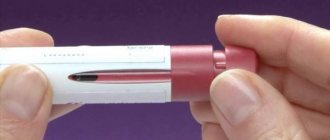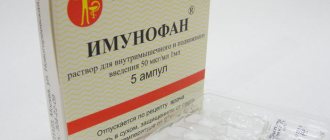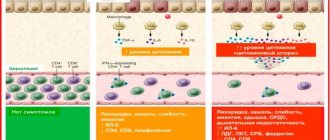Roncoleukin: indications for use
Adults use Roncoleukin (instructions for the drug, available in each package) as part of complex therapy for the following diseases:
- combined immunodeficiency conditions; - variable immunodeficiency; - acute form of pancreatitis; - osteomyelitis; - sepsis; - acute form of peritonitis; - endometritis; - severe form of pneumonia; - pulmonary tuberculosis; — various types of burns (chemical and thermal); - severe infections of different localization; - some forms of kidney cancer.
Children use Roncoleukin for the following diseases:
- combined and variable immunodeficiency; — peritonitis (acute form); - osteomyelitis; - pancreatitis (acute form); - sepsis; - severe form of pneumonia; - severe infections of various localizations.
Side effects
When using Roncoleukin, in some cases it is possible to develop systemic reactions, manifested in the form of a short-term increase in body temperature and chills during the administration of the solution. The symptoms are relieved by conventional therapeutic agents and are not grounds for interrupting the administration of the solution or canceling the treatment course.
Local reactions during subcutaneous administration may manifest as thickening, soreness and redness at the injection site.
When using Roncoleukin in a single dose of more than 7 mg, overdose symptoms such as fever, hypotension, heart rhythm disturbances, and dermatological allergic reactions were observed.
These symptoms stop after stopping the drug; if necessary, symptomatic therapy should be carried out.
Roncoleukin: instructions for use
Therapy with Roncoleukin is usually carried out after complex surgical interventions, which are carried out in order to minimize or eliminate causes that pose a direct threat to human life.
Roncoleukin is introduced into the human body by drops, intravenously or subcutaneously in a dose of 0.5 - 1.0 mg. with breaks of 1-3 days. For patients, the drug is taken for 1 – 3 administrations.
In the presence of severe sepsis, treatment with Roncoleukin is carried out in courses of one to three. Each course consists of 2 intravenous injections at a dose of 0.5 mg. with a break every other day. If lymphopenia persists with this therapy, a second and third course of treatment is prescribed.
For the treatment of destructive pulmonary tuberculosis, 3 internal infusions of 0.5 mg are administered. with a mandatory 48-hour break. This treatment is carried out in combination with the use of polychemotherapy.
For renal cell cancer (in various forms), the course of treatment with this drug consists of taking the drug according to the following scheme: - the day before surgery, the drug is administered subcutaneously or intravenously at a dose of 0.5 mg; — during the first 4 weeks of therapy, the drug is administered by intravenous infusion of 2.0 mg. in one day. After 1-2 months, repeated courses of therapy are carried out.
The drug is used for children by administering Roncoleukin drips intravenously. The use of the drug for children is similar to the dosage regimen for adults. The dosage of the drug is prescribed by the doctor depending on the age of the child. Namely: - children from birth to 1 month - 0.1 mg. in 30-50 ml of solution; - from 1 month to 1 year - 0.125 per 100 ml. solution; - from 1 year to 7 years - 0.25 mg. in 200 ml. solution; - from 7 to 14 children - 0.5 mg. in 200 ml of solution; - from the age of 14 years - 0.5 mg. in 400 ml. solution.
Release form and composition
Roncoleukin is available in the form of a solution for infusion and subcutaneous administration, which is a clear, colorless or light yellow liquid (1 ml in ampoules, 3 or 5 ampoules in one cardboard package).
Composition of 1 ml solution for infusion and subcutaneous administration:
- Active ingredient: human recombinant interleukin-2 – 100 mcg, 250 mcg, 500 mcg or 1000 mcg (100,000 IU, 250,000 IU, 500,000 IU or 1,000,000 IU);
- Auxiliary components: dithiothreitol, mannitol, ammonium bicarbonate, sodium lauryl sulfate, water for injection.
Ronkoleukin: price and sale
This drug is quite well known on the pharmacological market, so you can buy Roncoleukin without much difficulty in any pharmacy. In addition, you can purchase Roncoleukin, the price of which may differ slightly when purchased using this method, by ordering online. True, this greatly increases the risk of buying a fake, since the opportunity to personally verify the presence of a certificate of conformity is practically reduced to zero. Therefore, it is best to buy the drug in specialized medical institutions or directly from official representatives of the manufacturer. By purchasing Roncoleukin at appropriate points of sale, you can protect yourself from purchasing a product of poor quality.
Despite the good reviews about the drug, Roncoleukin still has a number of side effects, so it can only be used under the strict supervision of a doctor.
Contraindications
Absolute:
- Pulmonary heart failure of the third degree;
- Heart failure of the third degree;
- Autoimmune diseases;
- End stage RCC;
- Metastatic brain damage;
- Pregnancy period;
- Increased individual sensitivity to yeast;
- History of increased individual sensitivity to the main or auxiliary components of the drug.
Relative (Roncoleukin is used with caution):
- Decompensated liver failure;
- Chronic renal failure.
Roncoleukin and Transfer factor
Roncoleukin, the price of which is approximately 4,000 rubles for 5 ampoules, must be used more than once to achieve the desired effect. Transfer factor, which is a drug that performs all the same functions, costs about 2,000 rubles. In addition, taking Transfer Factor allows you to achieve good results in a short time, since it affects the human body much deeper and leads to dramatic positive changes. By restoring the DNA structure, Transfer Factor not only helps in treating the disease, but also eliminates the very cause of its occurrence and prevents the development of new diseases.
If, nevertheless, a decision is made to take the drug Roncoleukin, then the Transfer factor used in the complex will be able to neutralize the side effects and restore disorders in the immune system.
Reviews from doctors about Roncoleukin in oncology
According to many experts, the drug copes well with many manifestations of cancer: pain in the active stage of the pathological process is reduced, and the activity of dividing mutated cells slows down.
Roncoleukin has proven itself to be excellent in complex treatment: the possibility of complex therapy helps to achieve the most pronounced effect, and its compatibility with many drugs allows you to simulate the most effective treatment regimen.
Precautionary measures
Roncoleukin is considered a safe medicine, so no special personal preventive measures are required. It is recommended to remember the general rules for working with medicines (personal hygiene, etc.).
One day I had to inject myself. It’s almost impossible to make a mistake with an intramuscular injection (it’s easy to choose the injection site, and I learned to avoid blood vessels a long time ago), the mistake was elsewhere. Any person who has ever given an injection knows that some time passes between taking the solution from the ampoule and inserting the needle. This is the moment when you took the solution, put the syringe aside, prepared the injection site, and took the syringe. To ensure that the sterility of the needle is not compromised at this time, a cap is placed on it. If you press the cap too hard, it will “stick” to the cannula and you will have to forcefully remove it, which will lead to a puncture wound. Thus, I pricked all the fingers on my left hand.
It is better to break the ampoule with gloves or through a napkin, the cap on the syringe needle should not be put on too tightly, and used vials and ampoules should be disposed of immediately
Pharmacodynamics and pharmacokinetics
Roncoleukin is an immunostimulant and has antifungal, antitumor, antiviral and antibacterial activity.
Interleukin-2 actively influences the process of launching and further formation of the immune response, exhibits multiple effects on different parts and components of the human immune system.
Activates the proliferation of T-lymphocytes , which leads to their cytotoxic action as killer cells, while the spectrum of lysing effects expands to the possibility of effectively counteracting various pathogenic microorganisms and malignant cells.
Also stimulates the production of immunoglobulin by B-lymphocytes , increases the functionality of tissue macrophages and monocytes.
special instructions
The drug is compatible with most other veterinary drugs, however, when using it, the following rules should be observed: administration with any other drugs and vaccines in the same syringe is not recommended (with the exception of vaccination of birds); In addition, it is not recommended to dilute roncoleukin for animals in solutions containing glucose, due to a decrease in its level of activity.
After using roncoleukin for animals, meat and dairy products can be consumed for food purposes immediately and without any restrictions.
conclusions
- Due to enhancing immunity, antiviral and anti-inflammatory effects, the use of roncoleukin is highly effective in the therapeutic treatment of diseases of various etiologies.
- Unlike many synthetic antiviral drugs (cycloferon, etc.), roncoleukin does not create additional stress on the kidneys and pancreas, but rather improves their functioning. In this regard, it can be used in the treatment of older animals, both for infectious diseases and to boost immunity and improve general condition.
- The drug should be used carefully in animals with heart disease, as well as in the presence of autoimmune diseases.
- No drug should be treated as a panacea for all diseases. However, the use of roncoleukin is quite effective in treating a fairly wide range of diseases, including malignant tumors.
Order veterinary drugs
(click the link, fill in your contact information and in the field - Your question - write down the veterinary drugs, packaging and quantity you need. Carefully enter the contact information so that our manager can contact you)
Did you like the article? Share it with everyone! Thank you!
- Effective veterinary drugs, rules of use and instructions Catozal, what you didn’t know about, analogues, instructions, contraindications
- Homeopathic Veterinary Medicines or "Heel" and Company
- Effective veterinary drugs, immunostimulant "Roncoleukin"
- Effective veterinary drug Vetom and its use in animals and people
- Veterinary drug ASD, what is it, a fairy tale or reality
- Effective veterinary drugs – natural body stimulant nucleopeptide (Nycleopeptid)
- Microvitam and its use in veterinary medicine and animal breeding
Pharmacological properties
Interleukin-2 is produced by a subset of T lymphocytes (T helper I cells) in response to antigenic stimulation. Synthesized rIL-2 affects T-lymphocytes, enhancing their proliferation, as well as the subsequent synthesis of rIL-2. The biological effects of rIL-2 are mediated by its binding to specific receptors present on various cellular targets. rIL-2 specifically affects the activation, differentiation and growth of T and B lymphocytes, macrophages, monocytes, epidermal Langerhans cells, oligodendroglial cells, and increases the synthesis of all immunoglobulin isotypes by plasma cells. rIL-2 increases the production of interferons α, β, γ and reduces the level of spontaneous apoptosis of helper T-lymphocytes. The development of cytolytic activity of cytotoxic T-lymphocytes and natural killer cells depends on its presence. rIL-2 activates tumor-filtering cells and promotes the formation of lymphokine-activated killer cells. The expansion of the spectrum of the lysing action of effector cells causes the destruction of various pathogenic microorganisms, malignant and infected cells, which provides immune protection targeted against fungal, bacterial and viral infections, as well as against the growth of tumor cells.
Methods of administration
Subcutaneously: add 1.5-2 ml of water for injection or 0.9% sodium chloride solution to the contents of the bottle or ampoule and inject it into the neck area; for fish use 0.65% sodium chloride solution.
Intravenously: the contents of the bottle or ampoule are added to a dropper in which 0.9% sodium chloride solution for injection is used as a solvent and administered intravenously; in fish, a 0.65% sodium chloride solution is used and injected into the tail vein.
Intranasal: the contents of the bottle or ampoule are diluted in 5 ml of 0.9% sodium chloride solution and instilled in the following doses: 2 drops into each nasal cavity at least 3-5 times a day.
Externally: the contents of the bottle or ampoule are diluted in 10-20 ml of 0.9% sodium chloride solution and used as irrigation or application to the damaged wound surface.
Intravesical: the contents of the bottle or ampoule are diluted in 5-50 ml (depending on the size of the animal) of 0.9% sodium chloride solution and injected intravesically through a catheter into the bladder cavity.
Orally: the contents of the bottle or ampoule are diluted in 10 ml of 0.9% sodium chloride solution for injection and dispensed. The best effect is achieved by slowly pouring the solution under the tongue. Irrigation of feed is used in fish.
When diluting Roncoleukin for animals, there is no need to shake the ampoule vigorously to avoid increased foaming.






